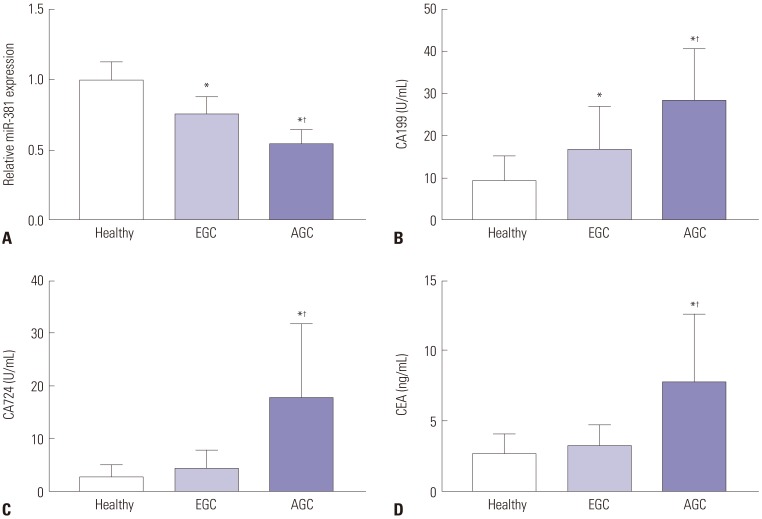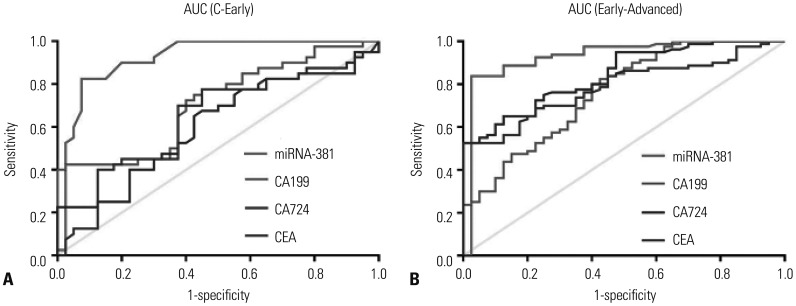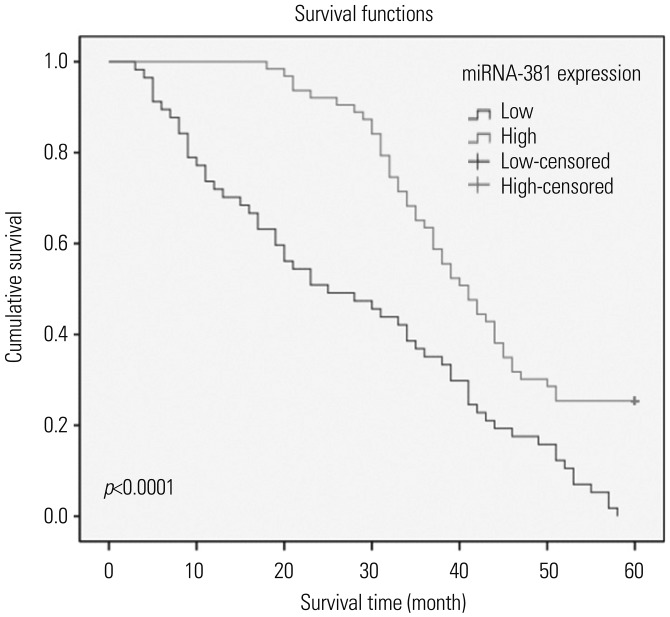Yonsei Med J.
2019 Aug;60(8):720-726. 10.3349/ymj.2019.60.8.720.
Serum microRNA-381: A Potential Marker for Early Diagnosis of Gastric Cancer
- Affiliations
-
- 1Department of Gastroenterology, The 5th People's Hospital of Ji'nan, Jinan, Shandong, China.
- 2Department of Gastroenterology, Jinan First People's Hospital, Jinan, Shandong, China.
- 3Department of Gastrointestinal Surgery, Shandong Institute of Cancer Prevention and Control, Jinan, Shandong, China.
- 4Department of Movement Control Section, Jinan Medical Emergency Center, Jinan, Shandong, China.
- 5Department of General Surgery, The 5th People's Hospital of Ji'nan, Jinan, Shandong, China. wangxinweidwyy@163.com
- KMID: 2452952
- DOI: http://doi.org/10.3349/ymj.2019.60.8.720
Abstract
- PURPOSE
The purpose of this study was to explore the potential early diagnostic value of serum microRNA-381(miRNA-381) in patients with gastric cancer (GC).
MATERIALS AND METHODS
Patients with advanced gastric cancer (AGC) and early gastric cancer (EGC), as well as healthy individuals, were enrolled in this study. Expression of miRNA-381 in serum was detected using real-time quantitative PCR. Electrochemiluminescence analysis was used to investigate the expression of classic tumor markers, including carbohydrate antigen (CA) 199, CA724, and carcinoembryonic antigen. Finally, receiver operating characteristic curve and Kaplan-Meier analysis were used to determine the value of miRNA-381 in clinical diagnosis of GC.
RESULTS
miRNA-381 was differentially expressed among the study groups. AUC analysis showed that the sensitivity and specificity of serum miRNA-381 in the diagnosis of GC were superior to those of other tumor markers. Furthermore, low levels of miRNA-381 expression were positively correlated with lymph node metastasis and AGC. Finally, Kaplan-Meier survival analysis showed that down-regulation of miRNA-381 was associated with lymph node metastasis and the development of GC.
CONCLUSION
miRNA381, which was down-regulated in GC, might be a novel early diagnosis marker for patients with GC.
MeSH Terms
Figure
Reference
-
1. Piazuelo MB, Correa P. Gastric cancer: overview. Colomb Med (Cali). 2013; 44:192–201. PMID: 24892619.2. Britto AV. [Stomach cancer: risk factors]. Cad Saude Publica. 1997; 13(Suppl 1):7–13.3. Brenner H, Rothenbacher D, Arndt V. Epidemiology of stomach cancer. Methods Mol Biol. 2009; 472:467–477. PMID: 19107449.
Article4. Choi NK, Youn KE, Heo DS, Lee SM, Kim Y, Park BJ. Stomach cancer incidence, mortality and survival rate in Korean Elderly Pharmacoepidemiologic Cohort (KEPEC) in 1994~1998. Cancer Res Treat. 2003; 35:383–390. PMID: 26680963.
Article5. Yoshida K, Yamaguchi K, Okumura N, Osada S, Takahashi T, Tanaka Y, et al. The roles of surgical oncologists in the new era: minimally invasive surgery for early gastric cancer and adjuvant surgery for metastatic gastric cancer. Pathobiology. 2011; 78:343–352. PMID: 22104206.6. Layke JC, Lopez PP. Gastric cancer: diagnosis and treatment options. Am Fam Physician. 2004; 69:1133–1140. PMID: 15023013.7. Lee EY, Lee YY, Suh M, Choi E, Mai TTX, Cho H, et al. Socioeconomic inequalities in stomach cancer screening in Korea, 2005–2015: after the introduction of the National Cancer Screening Program. Yonsei Med J. 2018; 59:923–929. PMID: 30187698.
Article8. McLean MH, El-Omar EM. Genetics of gastric cancer. Nat Rev Gastroenterol Hepatol. 2014; 11:664–674. PMID: 25134511.
Article9. Zhang T, Liu C, Huang S, Ma Y, Fang J, Chen Y. A downmodulated microRNA profiling in patients with gastric cancer. Gastroenterol Res Pract. 2017; 2017:1526981. PMID: 28546810.
Article10. Ishimoto T, Baba H, Izumi D, Sugihara H, Kurashige J, Iwatsuki M, et al. Current perspectives toward the identification of key players in gastric cancer microRNA dysregulation. Int J Cancer. 2016; 138:1337–1349. PMID: 26041092.
Article11. Zhou S, Ye W, Ren J, Shao Q, Qi Y, Liang J, et al. MicroRNA-381 increases radiosensitivity in esophageal squamous cell carcinoma. Am J Cancer Res. 2014; 5:267–277. PMID: 25628936.12. Liang Y, Zhao Q, Fan L, Zhang Z, Tan B, Liu Y, et al. Down-regulation of MicroRNA-381 promotes cell proliferation and invasion in colon cancer through up-regulation of LRH-1. Biomed Pharmacother. 2015; 75:137–141. PMID: 26320367.
Article13. Cao Q, Liu F, Ji K, Liu N, He Y, Zhang W, et al. MicroRNA-381 inhibits the metastasis of gastric cancer by targeting TMEM16A expression. J Exp Clin Cancer Res. 2017; 36:29. PMID: 28193228.
Article14. Zhang M, Huang S, Long D. MiR-381 inhibits migration and invasion in human gastric carcinoma through downregulatedting SOX4. Oncol Lett. 2017; 14:3760–3766. PMID: 28927144.
Article15. Livak KJ, Schmittgen TD. Analysis of relative gene expression data using real-time quantitative PCR and the 2(-Delta Delta C(T)) Method. Methods. 2001; 25:402–408. PMID: 11846609.16. Zhou H, Yang Y, Li C, Yu B, Zhang S. Enhanced iridium complex electrochemiluminescence cytosensing and dynamic evaluation of cell-surface carbohydrate expression. Chemistry. 2014; 20:14736–14743. PMID: 25234357.
Article17. Bland JM, Altman DG. Survival probabilities (the Kaplan-Meier method). BMJ. 1998; 317:1572. PMID: 9836663.18. Alberti C, Timsit JF, Chevret S. [Survival analysis - the log rank test]. Rev Mal Respir. 2005; 22(5 Pt 1):829–832. PMID: 16272989.20. Van Cutsem E, Sagaert X, Topal B, Haustermans K, Prenen H. Gastric cancer. Lancet. 2016; 388:2654–2664. PMID: 27156933.
Article21. Wang J, Wu S, Huang T. Expression and role of VEGFA and miR-381 in portal vein tumor thrombi in patients with hepatocellular carcinoma. Exp Ther Med. 2018; 15:5450–5456. PMID: 29904424.
Article22. Formosa A, Markert EK, Lena AM, Italiano D, Finazzi-Agro' E, Levine AJ, et al. MicroRNAs, miR-154, miR-299-5p, miR-376a, miR-376c, miR-377, miR-381, miR-487b, miR-485-3p, miR-495 and miR-654-3p, mapped to the 14q32.31 locus, regulate proliferation, apoptosis, migration and invasion in metastatic prostate cancer cells. Oncogene. 2014; 33:5173–5182. PMID: 24166498.
Article23. Rothschild SI, Tschan MP, Jaggi R, Fey MF, Gugger M, Gautschi O. MicroRNA-381 represses ID1 and is deregulated in lung adenocarcinoma. J Thorac Oncol. 2012; 7:1069–1077. PMID: 22592211.
Article24. Li Y, Zhao C, Yu Z, Chen J, She X, Li P, et al. Low expression of miR-381 is a favorite prognosis factor and enhances the chemosensitivity of osteosarcoma. Oncotarget. 2016; 7:68585–68596. PMID: 27612424.
Article25. Chen Y, Min L, Zhang X, Hu S, Wang B, Liu W, et al. Decreased miRNA-148a is associated with lymph node metastasis and poor clinical outcomes and functions as a suppressor of tumor metastasis in non-small cell lung cancer. Oncol Rep. 2013; 30:1832–1840. PMID: 23843100.
Article26. Fujino Y, Takeishi S, Nishida K, Okamoto K, Muguruma N, Kimura T, et al. Downregulation of microRNA-100/microRNA-125b is associated with lymph node metastasis in early colorectal cancer with submucosal invasion. Cancer Sci. 2017; 108:390–397. PMID: 28032929.
Article27. Shimada H, Noie T, Ohashi M, Oba K, Takahashi Y. Clinical significance of serum tumor markers for gastric cancer: a systematic review of literature by the Task Force of the Japanese Gastric Cancer Association. Gastric Cancer. 2014; 17:26–33. PMID: 23572188.
Article28. Ucar E, Semerci E, Ustun H, Yetim T, Huzmeli C, Gullu M. Prognostic value of preoperative CEA, CA 19-9, CA 72-4, and AFP levels in gastric cancer. Adv Ther. 2008; 25:1075–1084. PMID: 18821070.
Article29. Takahashi Y, Takeuchi T, Sakamoto J, Touge T, Mai M, Ohkura H, et al. The usefulness of CEA and/or CA19-9 in monitoring for recurrence in gastric cancer patients: a prospective clinical study. Gastric Cancer. 2003; 6:142–145. PMID: 14520526.
Article30. Mattar R, Alves de, DiFavero GM, Gama-Rodrigues JJ, Laudanna AA. Preoperative serum levels of CA 72-4, CEA, CA 19-9, and alpha-fetoprotein in patients with gastric cancer. Rev Hosp Clin Fac Med Sao Paulo. 2002; 57:89–92. PMID: 12118264.
Article31. Henry JC, Bassi C, Giovinazzo F, Bloomston M. MicroRNA from pancreatic duct aspirate differentiates cystic lesions of the pancreas. Ann Surg Oncol. 2013; 20(Suppl 3):S661–S666. PMID: 23884752.
Article32. Slattery ML, Herrick JS, Mullany LE, Samowitz WS, Sevens JR, Sakoda L, et al. The co-regulatory networks of tumor suppressor genes, oncogenes, and miRNAs in colorectal cancer. Genes Chromosomes Cancer. 2017; 56:769–787. PMID: 28675510.
Article33. Zhao FL, Dou YC, Wang XF, Han DC, Lv ZG, Ge SL, et al. Serum microRNA-195 is down-regulated in breast cancer: a potential marker for the diagnosis of breast cancer. Mol Biol Rep. 2014; 41:5913–5922. PMID: 25103018.
Article




